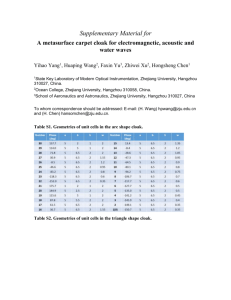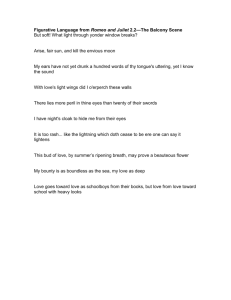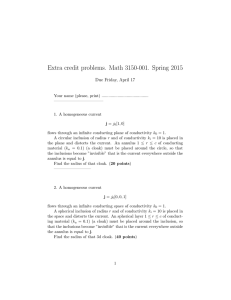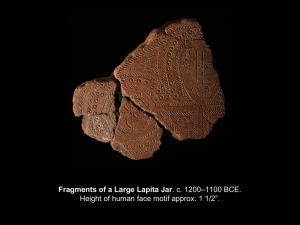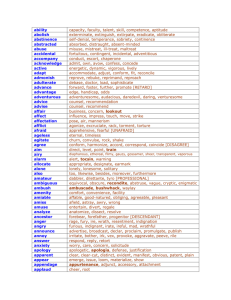Lorentz force and radiation pressure on a spherical cloak Please share
advertisement
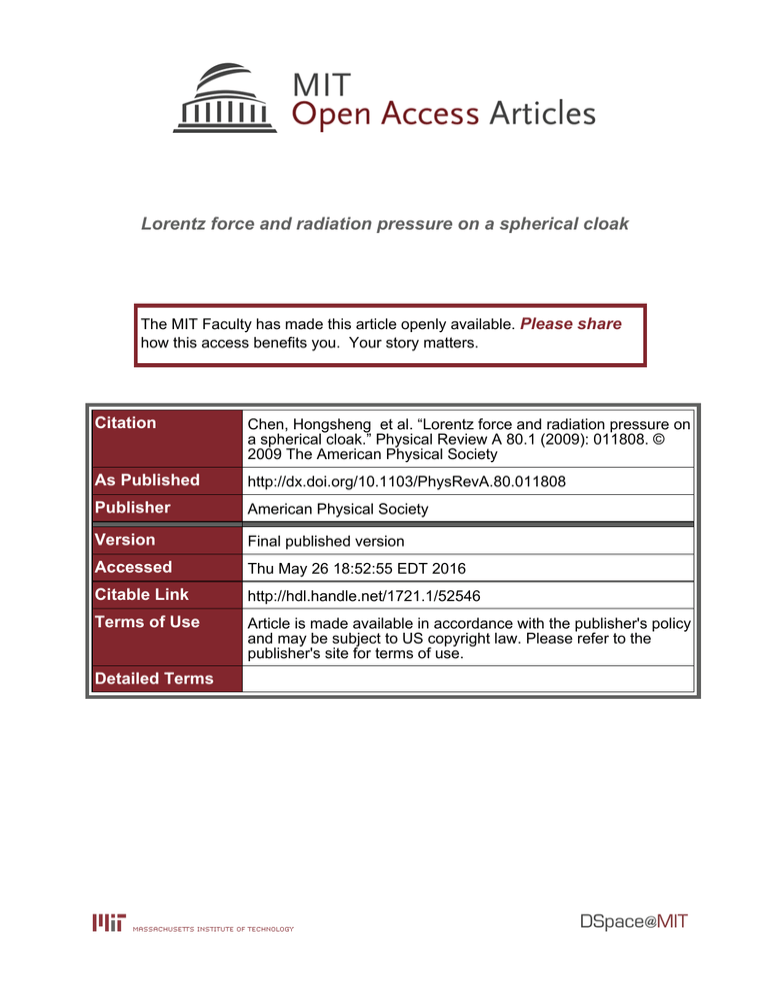
Lorentz force and radiation pressure on a spherical cloak The MIT Faculty has made this article openly available. Please share how this access benefits you. Your story matters. Citation Chen, Hongsheng et al. “Lorentz force and radiation pressure on a spherical cloak.” Physical Review A 80.1 (2009): 011808. © 2009 The American Physical Society As Published http://dx.doi.org/10.1103/PhysRevA.80.011808 Publisher American Physical Society Version Final published version Accessed Thu May 26 18:52:55 EDT 2016 Citable Link http://hdl.handle.net/1721.1/52546 Terms of Use Article is made available in accordance with the publisher's policy and may be subject to US copyright law. Please refer to the publisher's site for terms of use. Detailed Terms RAPID COMMUNICATIONS PHYSICAL REVIEW A 80, 011808共R兲 共2009兲 Lorentz force and radiation pressure on a spherical cloak Hongsheng Chen,1,2,* Baile Zhang,2 Yu Luo,1 Brandon A. Kemp,2,3 Jingjing Zhang,1 Lixin Ran,1 and Bae-Ian Wu1,2 1 The Electromagnetics Academy at Zhejiang University, Zhejiang University, Hangzhou 310027, China Research Laboratory of Electronics, Massachusetts Institute of Technology, Cambridge, Massachusetts 02139, USA 3 Laser Technology Development, Lexmark International, Inc., Lexington, Kentucky 40550, USA 共Received 23 May 2009; published 22 July 2009兲 2 The mechanical behavior of a transformation based spherical cloak under wave illumination is derived. We show that the equatorial region of the cloak is subject to much higher stress than the polar regions, where the polar axis is defined along the wave propagation direction. These forces do not exist before transformation but stem from the squeezed electromagnetic space. The trajectory of the ray can be interpreted as a result of the recoil force that the cloak exerts upon the ray. The total radiation pressure on an ideal cloak is shown to be exactly zero, effecting a stationary cloak. DOI: 10.1103/PhysRevA.80.011808 PACS number共s兲: 42.25.Fx, 41.20.Jb It is well known that electromagnetic waves carry both momentum and energy 关1,2兴. When light impinges onto a dielectric particle, part of the optical momentum will transfer to it 关3–6兴, and the radiation pressure will accelerate the particle. That is the reason why we can see the comet’s tail, which results from the radiation pressure of the sunlight pushing particles of the tail away from the comet. The recently proposed invisibility cloak 关7–9兴, which neither absorbs nor reflects light, will be immune to the light radiation pressure. The idea of cloak has been proposed based on the coordinate transformation method, where a hole is created in the transformed space and an object in the hole can be concealed from detection 关7–9兴. Compared with the cloak design based on other approaches, such as the scattering cancellation method 关10–12兴, the anti-object method 关13兴, and the dipole moment cancellation method using anomalous localized resonance 关14,15兴 etc., the transformation based design has advantages that it does not depend on the parameters of the hidden object. The ray tracing method 关7,16兴 and the full wave method 关17–22兴 have both shown that light can be smoothly guided around the transformation based cloak. Such interesting phenomena have been experimentally demonstrated by a two-dimensional cylindrical cloak with simplified parameters 关23兴, a ground-plane cloak 关24,25兴, and dielectric optical cloaks 关26,27兴. The reason that the rays are guided around the invisibility cloak can be interpreted as a result of the bending of electromagnetic space, which is always associated with some force appearance, such that the gravity is the appearance of the bent time and space. Therefore, a bent electromagnetic space must exhibit certain force properties and affect the mechanical behavior of light in physical space. Such mechanical behavior is a very fundamental physical problem associated with the transformed invisibility cloak but has not been revealed. In this Rapid Communication, the mechanical behavior of a general transformation based spherical cloak under planewave illumination is revealed based on Lorentz force, which links the Maxwell equations to mechanics in the theory of electromagnetics. We show that the equatorial region of the cloak is subject to much higher stress than the polar regions, *chenhs@ewt.mit.edu; hansomchen@zju.edu.cn 1050-2947/2009/80共1兲/011808共4兲 where the polar axis is defined along the wave propagation direction. These forces do not exist before transformation but stem from the squeezed electromagnetic space and are one of the ways that it appears in physical space. In addition, the force distribution exhibits a symmetric pattern in the cross section perpendicular to the wave propagation direction, therefore the total radiation pressure on an ideal cloak is exactly zero. The trajectory of the ray inside of the cloak can be interpreted vividly as a result of the recoil force that the cloak exerts upon the ray. The three-dimensional spherical cloak we consider here has an inner radius R1 and outer radius R2. The cloak shell within R1 ⬍ r ⬍ R2 is a radially uniaxial and inhomogeneous ˆ ˆ and medium with permittivity tensor ⑀ញ = ⑀rr̂r̂ + ⑀tˆ ˆ + ⑀t ˆ ˆ ˆ ˆ ញ = rr̂r̂ + t + t. The constitutive permeability tensor parameters ⑀t, ⑀r, t, and r can be derived based on the transformation method 关7兴: ⑀t/⑀0 = t/0 = f ⬘共r兲, ⑀ r/ ⑀ 0 = r/ 0 = f 2共r兲 , r2 f ⬘共r兲 共1兲 where ⑀0 and 0 are the permittivity and permeability of free space, f共r兲 is the general transformation function between the original spherical coordinate system 共r⬘, ⬘, ⬘兲 and the physical spherical coordinate system 共r, , 兲 关28兴. An Ex polarized plane wave with unit amplitude, Ei = x̂eik0z, is incident upon the spherical cloak, where k0 = 冑0⑀0 is the wave number in free space. The time dependence of e−it is assumed and is suppressed in the following part. Based on the Mie scattering model 关18,28兴, the electromagnetic fields inside the coated layer can be calculated as follows: Erc = f ⬘共r兲sin cos eik0 f共r兲cos , Hrc = f共r兲 cos cos eik0 f共r兲cos , r Hc = Ec = Ec = − f共r兲 sin eik0 f共r兲cos , r Hc = − Erc 0 Ec 0 Ec 0 tan , tan , cot , 共2兲 where 0 = 冑0 / ⑀0 is the impedance in free space. Note that the fields in the core are zero, while the fields outside of the 011808-1 ©2009 The American Physical Society RAPID COMMUNICATIONS PHYSICAL REVIEW A 80, 011808共R兲 共2009兲 CHEN et al. cloak 共air region兲 can be expressed using Eq. 共2兲 with the transformation function determined by f air共r兲 = r. Once the fields inside the spherical cloak are obtained, the force inside the medium can be calculated. The time-average Lorentz force density due to the harmonic wave excitation is 关5兴 Ex(V/m) + i0M̄ ⫻ ⑀0Ē 其, 冋 册 f共r兲 cos . + ˆ r z[λ0] r̂f ⬘共r兲sin 共4兲 On the outer surface of the cloak, Eq. 共3兲 is simplified to 1 具f̄ surf 典 = Re兵eĒⴱavg + hH̄ⴱavg其, 2 0 -0.5 共5兲 where e = r̂ · ⑀0共Ēair − Ēc兲 and h = r̂ · 0共H̄air − H̄c兲 are the bound electric and magnetic surface charge densities, respectively, and Ēavg = 共Ēair + Ēc兲 / 2 and H̄avg = 共H̄air + H̄c兲 / 2 are the average electric and magnetic fields at the surface 关3,29兴. Substitution of Eq. 共2兲, the fields in the free space and the fields in the core into Eq. 共5兲 yields the following surface force density at r = R2 and r = R1, respectively: -1 -1.5 -2 共3兲 册冋 0.5 2 10 -11N/m 3 -10 3x10 N/m 0 -1 where Re兵 其 represents the real part of a complex quantity and ⴱ denotes the complex conjugate. The polarization and magnetization are defined as P̄ = D̄ − ⑀0Ē and 0M̄ = B̄ − 0H̄, respectively. All of them are functions of r̄. The leading two terms in Eq. 共3兲 contribute via a force density on bound electric and magnetic charges, while the final two terms represent the force density on bound electric and magnetic currents and free electric and magnetic currents. First, let us focus on the final two terms. In an ideal lossless cloak, by using Eqs. 共1兲 and 共2兲, we can obtain that the force density on the electric and magnetic currents 21 Re兵−i共⑀ញ − ⑀0Iញ兲Ē ញ − 0Iញ兲H̄ ⫻ ⑀0Ēⴱ其 is zero everywhere. Thus we ⫻ 0H̄ⴱ + i共 can conclude that the force inside the ideal cloak is contributed only from the bound electric and magnetic charges. Second, we can calculate the first two terms in Eq. 共3兲. In a source free region, ⵜ · D̄ = 0 and ⵜ · B̄ = 0, we can get −ⵜ · P̄ = ⑀0 ⵜ · Ē and −ⵜ · 0M̄ = 0 ⵜ · H̄. In a homogenous material, both ⵜ · Ē and ⵜ · H̄ are zero everywhere, therefore the force density on the bound electric and magnetic charges exist only at the boundary of two homogenous materials 关3兴. However, in the spherical cloak layer, the materials are both anisotropic and inhomogeneous, the force density on bound electric and magnetic charges exist everywhere. Substitution of Eq. 共2兲 into Eq. 共3兲 yields the bulk force density in the region of R1 ⬍ r ⬍ R2: 1 2f ⬘共r兲 2f共r兲 具f̄ bulk典 = ⑀0 sin f ⬙共r兲 + − 2 2 r r 1 1 1 具f̄典 = Re兵共− · P̄兲Ēⴱ + 共− · 0M̄兲H̄ⴱ − i P̄ ⫻ 0H̄ⴱ 2 ⴱ 1.5 2 -2 -1 0 x[λ0] 1 2 FIG. 1. 共Color online兲 The Lorentz force density 共arrows兲 on the ideal linearly transformed spherical cloak with R1 = 0 and R2 = 20 results from an Ex polarized plane wave of unit amplitude incident from free space with wavelength 0 = 0.1 m. The bulk force density 共unit: N / m3兲 is represented by black arrows, while the surface force density 共unit: N / m2兲 is represented by green arrows. The background pattern is the electric field distribution 共unit: V/m兲. 再 1 1 具f̄ r=R2典 = ⑀0 sin r̂ 关1 − f ⬘2共R2兲兴sin 2 2 冎 + ˆ 关1 − f ⬘共R2兲兴cos . 共6兲 1 具f̄ r=R1典 = r̂ ⑀0 f ⬘2共R1兲sin2 . 4 共7兲 It is interesting to see that both the bulk force density and ˆ component, which means the surface force density have no that there is no angular momentum transfer along the z axis due to the rotational symmetry of the spherical cloak. In addition, while the surface force at the outer boundary has both r̂ and ˆ components, the surface force at the inner boundary has only r̂ component because there are no tangential field components at the inner surface. The role of these forces will be illustrated in the later part of the Rapid Communication. We take a linearly transformed spherical cloak 关7兴 R2 where f共r兲 = R2−R 共r − R1兲 as an example. The constitu1 tive parameters of the linearly transformed spherical R2 r−R R2 R2 cloak are ⑀t = ⑀0 R2−R , ⑀r = ⑀0 R2−R 共 r 1 兲2, t = 0 R2−R , and r 1 1 1 R2 r−R1 2 = 0 R2−R 共 兲 . Substituting the linear transformation funcr 1 tion into Eqs. 共4兲, 共6兲, and 共7兲, the force distribution inside the linearly transformed cloak therefore can be obtained. Assume the incident wave has a wavelength of 0 = 0.1 m and the cloak has a size of R1 = 0 and R2 = 20, we can calculate the total electric field intensity and the force density inside the cloak. Figure 1 shows the results on the xz plane. We can see that the surface forces 共green arrows兲 on the outer surface of the cloak point inward but not exactly toward the center, while the surface forces on the inner surface of the cloak point outward. We can also see that the bulk forces 共black arrows兲 in the region of R1 ⬍ r ⬍ R2 point outward but not exactly from the center. In order to view the force clearly, we 011808-2 RAPID COMMUNICATIONS LORENTZ FORCE AND RADIATION PRESSURE ON A … PHYSICAL REVIEW A 80, 011808共R兲 共2009兲 -10 (a) z[λ0] r 2 1 θ 1 2 x10 N/m3 3 (b) θ x[λ0] r component 2 1 0 -11 x10 N/m3 3 z[λ0] r 2 1 θ 1 2 2 θ 1 x[λ0] 0 -1 -1 -2 -2 -3 θ component plot the magnitude of each component of the bulk force in Fig. 2, where Fig. 2共a兲 shows the r̂ component of the bulk force while Fig. 2共b兲 shows the ˆ component of the bulk force on the xz plane. The r̂ component of the bulk force is positive, creating tension that expands the cloak medium. The ˆ component of the bulk force shown in Fig. 2共b兲 shows a symmetric pattern on the xz plane: in the region of ⬎ 0 it is positive, while in the region of ⬍ 0 it is negative. If we define the polar axis to be along the wave propagation direction, i.e., the z direction here, we can see that both the bulk force and surface force at the polar regions, which corresponds to = 0 and = , are exactly zero. This means that the polar regions 共at = 0 and = 兲 withstand no force while the lateral region 共at = / 2兲 withstands maximum stress. It should be noted that all the bulk force and the surface force are rotationally symmetric along the z axis, as shown in Fig. 3. Therefore the total Lorentz force for an ideal cloak is exactly zero, which means there is no net momentum transfer from the electromagnetic wave to the cloak. However, the expanding force along the r̂ direction and the shrinking force along the −r̂ direction are not in balance. The total force on the half cloak located for x ⬎ 0 is 1.82⫻ 10−13 N along +x direction, while the total force on the other half cloak located for x ⬍ 0 is the same but along −x direction. The two equal forces pull the two halves of the cloak in opposite directions. Therefore, the effect is creating tension to expand the cloak but the total force on the whole cloak is zero. The above analysis is helpful to understand the mechanical interactions of the electromagnetic wave with the cloaking material. The forces that are exerted by the electromagnetic fields upon matter change the momentum of the FIG. 2. 共Color online兲 共a兲 r̂ component of the bulk force and 共b兲 ˆ component of the bulk force on the xz plane. -3 material object and/or create stresses within. Likewise, equal and recoil forces exist upon the electromagnetic fields. In this case, the momentum of the cloak is unchanged, while the induced material stresses shown in Figs. 1 and 2 exert equal and recoil stresses upon the wave fields. We show in Fig. 4 how the rays feel the force when propagating through the cloak. When ray 1 is incident onto the cloak at the position of P1, it feels a force with +r̂ and −ˆ components. The refracted ray therefore deviates from its original path and bend to left. If we plot the tangent of the surface illustrated as the red dashed line, we see that the angle of refraction is larger than the angle of incidence. When the ray propagates further into the cloak, for example, at position of P2, the ray is subject to a force with −r̂ and +ˆ components. We can imagine the ray enters from an outer layer to an inner layer with the tangent of the interface illustrated as a red dashed line because the cloak material are inhomogeneous along the r̂ direction. Therefore the force upon the ray bends the refracted ray to the right, i.e., the angle of refraction is smaller than the angle of incidence at the interface of P2. At P3, the ray enters the interface from an inner layer to an outer layer and feels a force with −r̂ and −ˆ components, which force the ray to bend to the right. At P4, the ray feels a force with +r̂ and +ˆ components, which leads the ray back to its origi-10 3x10 P4 P3 N/m -11 3 0.5x10 N/m 2 P8 P7 z x P6 P2 10-11 N/m2 P1 3x10-10 N/m3 P5 y (H) z(k) Ray 1 x(E) FIG. 3. 共Color online兲 The bulk force density 共unit: N / m3兲 represented by black arrows and the surface force density 共unit: N / m2兲 represented by green arrows on the z = 0 plane. Ray 2 Ray 3 Ray 4 FIG. 4. 共Color online兲 The rays are subject to equal and recoil forces when propagating through the cloak. The bulk force density at P2, P3, P6, and P7 are represented by black arrows and the surface force density at P1, P4, P5, and P8 are represented by magenta arrows. The red dashed line represent the tangent of the interface. 011808-3 RAPID COMMUNICATIONS PHYSICAL REVIEW A 80, 011808共R兲 共2009兲 CHEN et al. nal propagating direction. For a ray close to the center axis, e.g., ray 2, we can see that it is almost subject to no force when entering into the cloak, i.e., at P5. That is the reason why its path does not deviate much in the vicinity of P5. However, when it propagates around to the inner surface of the cloak, it feels an attractive force roughly pointing to the center. Therefore, the −r̂ force plays the role of “centripetal force” under which the photons are able to do the circulating motion. Because only r̂ component of force exists at the inner boundary of the cloak, the more the incident ray is close to the center axis, the more the ray follows a circle trajectory in the region close to the inner surface. The trajectory of other rays, e.g., rays 3 and 4, can be understood in a similar way. Our Rapid Communication therefore provides a different viewpoint to confirm the wave guidance of the cloak that was proposed in Ref. 关7兴. We can also see that the cloak is stressed outward at the z = 0 plane from Fig. 3. Because the force density upon the material is approximately outward from the center, the electromagnetic wave in this vicinity is subject to stress that tends to pull the wave toward the center of the cloak. As the wave propagates around the center of the cloaked region, the expansion of the cloak tends to pull photons toward the center 共x = 0 , y = 0兲 axis before exiting the cloaking material on the unilluminated side. Because we have derived the force expressions from the Chu formulation 共EH representation兲, we believe the energy/momentum subsystem separation to be made based inherently upon what is field and what is matter 关30兴. In this view, the electromagnetic wave momentum decreases as it enters the cloaked region on the illuminated side, resulting in a force with a +ẑ component. Likewise, the photons gain momentum upon exiting the unilluminated side, restoring the original momentum and exerting a −ẑ component of force upon the surface of the cloak. Furthermore, for a spherical cloak created with a general transformation function, the trajectory of the ray inside of the spherical cloak will be different but still can be explained as a result of the opposite force that the cloak exerts upon the ray. In conclusion, we reveal the mechanical behavior of the spherical cloak impinged on by a monochromatic plane wave. Our results show that the electromagnetic force exhibits a symmetric pattern in a cross section perpendicular to the wave propagation direction. These forces do not exist before transformation but stem from the squeezed electromagnetic space and are one of its appearance in the physical space. The trajectory of the ray can be understood as a result of the recoil Lorentz force it feels when propagating through the cloak. The total radiation pressure on an ideal cloak is shown to be exactly zero. Our Rapid Communication also provides some potential applications of the transformation based cloak in the astronomic area, such as protecting the satellite from orbital perturbations due to the solar radiation pressure. 关1兴 J. A. Kong, Electromagnetic Waves Theory 共EMW Publishing, Cambridge, MA, 2005兲. 关2兴 J. A. Stratton, Electromagnetic Theory 共McGraw-Hill, New York, 1941兲. 关3兴 M. Mansuripur, Opt. Express 12, 5375 共2004兲. 关4兴 B. A. Kemp, T. M. Grzegorczyk, and J. A. Kong, Opt. Express 13, 9280 共2005兲. 关5兴 B. A. Kemp, T. M. Grzegorczyk, and J. A. Kong, Phys. Rev. Lett. 97, 133902 共2006兲. 关6兴 R. Loudon and S. Barnett, Opt. Express 14, 11855 共2006兲. 关7兴 J. B. Pendry, D. Schurig, and D. R. Smith, Science 312, 1780 共2006兲. 关8兴 U. Leonhardt, Science 312, 1777 共2006兲. 关9兴 A. Greenleaf, M. Lassas, and G. Uhlmann, Physiol. Meas. 24, 413 共2003兲. 关10兴 A. Alu and N. Engheta, Phys. Rev. E 72, 016623 共2005兲. 关11兴 A. Alu and N. Engheta, Phys. Rev. Lett. 100, 113901 共2008兲. 关12兴 A. Sihvola, Prog. Electromagn. Res. 66, 191 共2006兲. 关13兴 Y. Lai, H. Y. Chen, Z. Q. Zhang, and C. T. Chan, Phys. Rev. Lett. 102, 093901 共2009兲. 关14兴 G. W. Milton and N.-A. P. Nicorovici, Proc. R. Soc. London, Ser. A 462, 3027 共2006兲. 关15兴 G. W. Milton, N.-A. P. Nicorovici, R. C. McPhedran, K. Cherednichenko, and Z. Jacob, New J. Phys. 10, 115021 共2008兲. 关16兴 D. Schurig, J. B. Pendry, and D. R. Smith, Opt. Express 14, 9794 共2006兲. 关17兴 S. A. Cummer, B. I. Popa, D. Schurig, D. R. Smith, and J. B. Pendry, Phys. Rev. E 74, 036621 共2006兲. 关18兴 H. S. Chen, B. I. Wu, B. Zhang, and J. A. Kong, Phys. Rev. Lett. 99, 063903 共2007兲. 关19兴 B. Zhang, H. S. Chen, B. I. Wu, Y. Luo, L. Ran, and J. A. Kong, Phys. Rev. B 76, 121101共R兲 共2007兲. 关20兴 Z. Ruan, M. Yan, C. W. Neff, and M. Qiu, Phys. Rev. Lett. 99, 113903 共2007兲. 关21兴 R. Weder, J. Phys. A: Math. Theor. 41, 065207 共2008兲. 关22兴 R. Weder, J. Phys. A: Math. Theor. 41, 415401 共2008兲. 关23兴 D. Schurig, J. J. Mock, B. J. Justice, S. A. Cummer, J. B. Pendry, A. F. Starr, and D. R. Smith, Science 314, 977 共2006兲. 关24兴 J. Li and J. B. Pendry, Phys. Rev. Lett. 101, 203901 共2008兲. 关25兴 R. Liu, C. Ji, J. J. Mock, J. Y. Chin, T. J. Cui, and D. R. Smith, Science 323, 366 共2009兲. 关26兴 J. Valentine, J. Li, T. Zentgraf, G. Bartal, and X. Zhang, Nature Mater. 8, 568 共2009兲. 关27兴 L. H. Gabrielli, J. Cardenas, C. B. Poitras, and M. Lipson, e-print arXiv:0904.3508. 关28兴 Y. Luo, H. S. Chen, J. J. Zhang, L. Ran, and J. A. Kong, Phys. Rev. B 77, 125127 共2008兲. 关29兴 B. A. Kemp, T. M. Grzegorczyk, and J. A. Kong, J. Electromagn. Waves Appl. 20, 827 共2006兲. 关30兴 B. A. Kemp, J. A. Kong, and T. M. Grzegorczyk, Phys. Rev. A 75, 053810 共2007兲. This work was sponsored by the NSFC 共Grants No. 60531020 and No. 60801005兲, the NCET-07-0750, the ZJNSF 共Grant No. R1080320兲, the MEC 共Grant No. 200803351025兲, the ONR 共Grant No. N00014-06-1-0001兲, and the USAF 共Grant No. FA8721-05-C-0002兲. H.C. thanks Dr. T. M. Grzegorczyk for enlightening discussions. 011808-4
